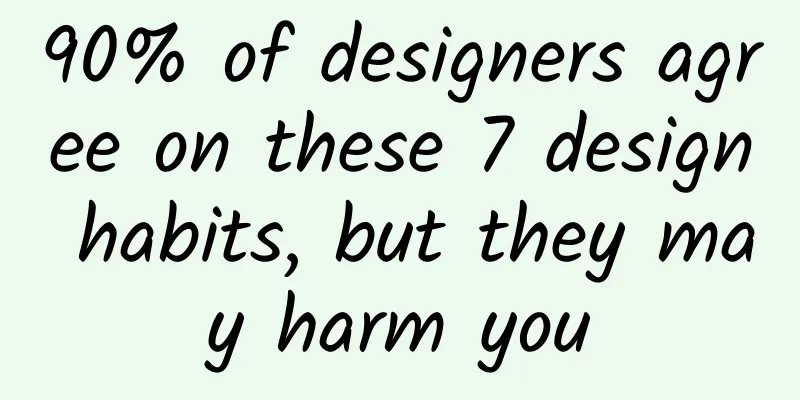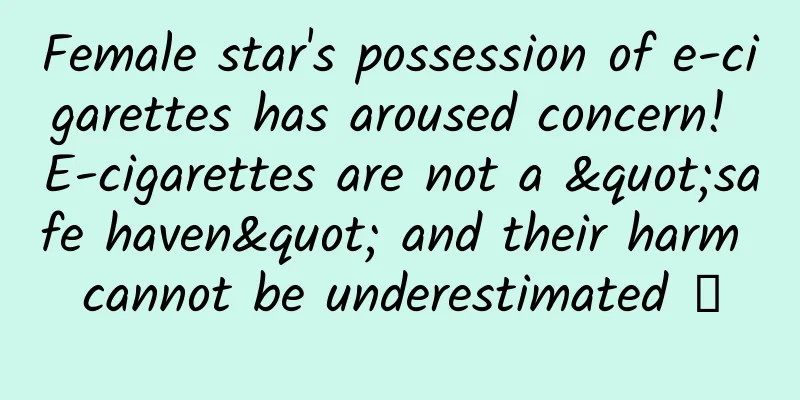90% of designers agree on these 7 design habits, but they may harm you

|
When many designers first start designing, they may look for design specifications everywhere and follow some trends and principles blindly. This often does not make mistakes. But as experience grows, you will slowly find that if you just mechanically apply specifications without adding your own thinking, it will be difficult to make a breakthrough. As a person in charge of user experience design at a university with more than 10 years of work experience, the author of this article summarizes some of his experiences to help us break through ourselves on the road of design growth. When writing this article, I may be challenging some design authorities and some design habits that everyone, including myself, used to agree with. So this article may make some people feel resistant, but please forgive me for writing them. After working for more than 10 years, I look back at the conflicts in those projects, such as the failure of development to implement the design, unreliable design concepts, and the difficulty in advancing the project progress. This article should have been written a long time ago. I used to think of shifting the blame to people outside the UX team, but this is neither honest nor objective. In general, when a project fails or is not done well, it is more important to look for problems within yourself. First of all, I have to state that I love design and UX research. But there are also some annoying aspects. Usually, UX research is a good way to solve the problems that a company's products encounter in the market. But sometimes, UX can also be part of the problem, and I often get caught in it. In daily life, I find that the solution to a problem usually comes with some costs, and solving a problem often creates a new problem. I have experienced similar things myself in product user experience design. When our user research team solves some problems for the company, it often brings up more problems. So, I want to break some "bad habits" in user experience through this article. Specifically, I will summarize some mistakes that myself and my team have made, which have also limited the development and experience of the product. At the same time, I will also challenge some of the empiricism inherent in the industry. This article is both a record of the industry problems I have encountered and a list of problems in the UX industry that make me uncomfortable. This article may challenge some of the traditional ideas of the public, but I still want to write them down because these are some of my own real experiences. 1. Blindly using design principles △ Image source: https://dribbble.com/shots/5525803-Design-principles I don't know if it's because I don't like to play by the rules, but when someone tells me a rule, I can't help but question it or try to break it. I haven't always been like this. When I first started working, I would honestly follow the rules. At that time, I didn't know there were better rules, and I was too young to experience problems with those rules. We are designers and we are also good at thinking. Rules are just to help us be lazy to some extent. But here, I am not saying that there are no good design principles in design or that there is no need to follow rules at all. I just suggest not to blindly apply rules. No matter what rules you use before designing, you need to think. The following principles are UX principles that can be found by just searching:
The above mentioned points are more of a guide than a design principle. Just like the example I will talk about below, it is stupid to be consistent just for the sake of consistency. Generally speaking, it is not wrong to say that you are not a real user. However, in some design research, it is appropriate to treat yourself as a user, which can add another dimension of data to the research. This is the so-called "immersive research". However, no matter what type of research, it is just a data representation. Users can't always tell you what they need, and they don't even know what they want. The “magic number: 7 ± 2” principle is a classic example of a research result that was misused, or, as Edward Tufte said, people didn’t really understand it. (Translator’s note: The magic number: 7 ± 2, this principle refers to the limitation of human information processing ability. The human brain can process about 7 pieces of information at the same time, with a floating range of 5 to 9) It seems like every week or month, a new trend becomes popular in our industry, and then not long after, that trend becomes the golden rule until it is forgotten or the next new trend comes along. I am tired of these so-called design trends, especially when they are blindly followed by designers. I am tired of following the rules and realizing that they don't always work. Some designers don’t always follow the rules. In fact, they often break the rules to create amazing designs. Of course, this requires experience. Design is made up of rationality and sensibility. Great art often breaks the rules. 2. Blindly following design trends △ Image source: https://dribbble.com/shots/3974926-Visual-Language Once or twice a year, I notice a new topic emerging in the UX community. Someone posts an article or a conference and then, with their help, it slowly gains followers and becomes a trend. A few years ago, the hamburger icon was one of these topics. The basic fact of the argument of those who oppose the hamburger icon is that it is not easy to find and recognize in A/B testing, which makes users unable to understand the use of the hamburger icon. As a result, the hamburger icon has been demonized and considered not to be used. However, people ignore the fact that an icon becomes an icon through cognitive universality. Icons are a language, a symbol that represents a concept, just like using alphabetic symbols to record sounds. Lean UX is another trend that emerged a few years ago. Although we have tried to free our profession from the "results-only" mentality, as long as you search in the search tool, you will find that we are still in the era of only looking at results and not processes, because there are a lot of articles teaching you how to write a good PPT of results. Mobile design is probably my favorite example. Mobile design is all about following the crowd. I've been involved in countless mobile design failures, and at some point in time I thought some of the ideas were really great. However, I've been scarred by those failures, and now I'm wary of any advice on mobile design. Just because you can port something to mobile doesn't mean you should. Many teams just follow the crowd because everyone else is doing it. If you spend a lot of time paying attention to articles about a particular trend (like I have for many years), you may find that trends are a very unreliable thing. About 5-10 years later, when you look back at the clothes that you think are very cool now, you will only laugh at yourself for being so non-mainstream at the time. User experience is no exception. In 5 years, you will start to laugh at what is popular now. There are also trends that last forever in our industry. These theoretical trends are usually based on solid fundamentals, general rules that we have spent decades studying and applying. Like Levi's 501s and solid color printed tees, they never go out of style. However, most trends are abandoned by the wayside, and following them will make your product lose its way and eventually disappear in the torrent of history. So what can we do to avoid following the trend? The general experience is: stay away from trends, stay away from the crowd, and follow your own rhythm, no matter how big the rhythm is or how far away you are. As for those popular trends, they do have reasons for existence or have a certain rationality. But you just need to be clear that your choice is not just because others are using it. Don't just think of putting some functions in the product on the mobile terminal because they can generate revenue on the PC; don't believe its point of view just because you read an article and just casually quoted a research result. In general, be critical and strategic about the knowledge you absorb. 3. Paying too much attention to details △ Image source: https://dribbble.com/shots/4605344-Search-icon-interaction I don’t know if being theoretical and detail-oriented is a personality trait of UX designers. I don’t really think about it that way, because I know many designers are not. However, I have never met any profession that is so obsessed with details as designers, who discuss the smallest details endlessly, and sometimes even stop a project because of it. Yes, details are important. I agree. When you have the time and resources to work on the small details, you should do it. But I often see some UX teams ignore the big problems while chasing the small details. It's like worrying about the backyard pantry when the house is on fire. I've been discussing whether to use toggle switches or checkboxes, radio buttons or drop-down menus, rounded or square corners, multi-select dialog boxes, colors, button positions, grid specifications, etc. The discussions lasted for weeks or months, and if the emails had thickness, they would probably be longer than the arms and legs of an NBA All-Star. But here’s a question I always ask: Does it really affect the user experience? Do users really care about rounded corners? Does it affect their experience? Do they care that all components are aligned to the grid? I spend a lot of time on these details, but rarely do users comment on a detail that I’ve discussed with my team. Instead, it’s the things that we never thought of that become problems, the things that we should have spent more time discussing, but didn’t. I admit that I used to get caught up in this kind of detail discussion, even recently. We would spend a lot of time discussing these details (mostly about the visual aspects of the interface). We would also set up a group to "investigate" these issues and do user testing. But at some point, I would calm down and think about the impact of these details on the overall design. Usually, from the overall perspective, it has little impact on the user experience. You need to always ask yourself this question: Do users care about the problems I think must be solved? 4. Lazy design consistency △ Image source: https://dribbble.com/shots/5549646-5-Column-Grid Consistency is important, but I believe that the law of diminishing returns also applies to product design. How much time are you willing to spend to make every interface absolutely consistent? Time is money, can this time get an equal return? Obviously, a complete lack of consistency between screens, where every screen looks completely different, can cause a lot of problems. But if a button on one screen is a few pixels off from the same button in another screen, does that really affect the user experience? You could call it a sloppy design, but it won’t actually lead to the failure of a new product launch. I'm not suggesting that you ignore consistency or the little details I mentioned above, but I'm suggesting that you balance the effort you put into these things with the return on your investment. If you use atomic design on a large system, it may take a lot of work up front, but if you balance it well, you may get a bigger return than the time you save in design and iteration. But at some point, the law of diminishing returns will set in, and it's time to reevaluate. Consistency also depends on context. Think about the search component in the system. We assume a way to interact with the search component and then declare that it works in exactly the same way in the product. This seems logical, right? We want search to work the same way throughout the system, not in different ways in different places. But the problem has actually occurred. We put consistency above user experience. You might ask, isn't it better for the user experience to use the same functional form? Yes, when they are used as a usage experience, there is no problem. But when they are strictly applied, there may be problems. For example, in the search control just now, different search functions may be used in different parts depending on the complexity of the search, the number of possible results, and the size of the database being searched. Don’t fall into the trap I once made: print out every screen in your app, post it on a wall, and then spend weeks or months going over every detail to ensure consistency. This is often a big job for me, but when it comes time to release, I realize there are more important things to do. The context of the user experience should take precedence over consistency. Designers should not be too rigid in following design consistency, but should design for the scenarios in which users use the feature. When designing a user experience, designing for consistency just for the sake of consistency is usually just a mindless and lazy approach. 5. Too much focus on project time △ Image source: https://dribbble.com/shots/2098871–Twas-the-night-before-deadline This may be more of a project management issue than a user experience issue. However, in my career, almost every team I worked with set a release cycle, including myself. Every time you make a product, you must set a deadline and let the entire team use all their time and resources to develop this product. But when you only focus on the deadline and ignore the experience and product, you are actually selling your soul to the company. Don't let the deadline become your motivation to move forward. I rarely see a project meet the deadline, but it happens, but not often. This means that the project timeline actually has room for relaxation (because they are usually a time forecast made by financial issues and implemented by project managers who do not understand the product features or the complexity involved). This means that you actually have time to do the research you want to do or design the next iteration. However, this question actually reflects what we need to focus on and what we should ultimately pursue in product design and experience. We often focus too much on deadlines, milestones, and release dates, and forget what we are actually trying to do well. Nothing annoys me more than a project manager sitting at my desk who suggests that if we don't meet milestones or deadlines, we are in danger. The deadline is not our goal. In my reality, I have to remind myself that I am doing a good job of providing a good user experience for my patients, which is my "primary goal". I don't need to attend a meeting every morning to set a deadline for the next phase. Completing the set goals within this deadline is secondary, and the core goal is the patient experience. The problem is: you can meet the deadline, please your boss and project manager, but the product is shit. I've done this many times, and it's not a win in the long run, and it's hard to make a great product. Don't focus too much on the deadline, focus more on user experience and make sure your product is on the right track for the long run. 6. Instrumentalism △ Image source: https://dribbble.com/shots/4887261-Tools If I have to listen to one more debate about the pros and cons of design tools, I think I might hang myself with an unused tie. Not long ago, I had a bad time working with a consulting team that had the audacity to suggest that using a certain tool would give the team a competitive advantage in future work. This was such garbage that I wondered if they were getting kickbacks or were just brainwashing themselves. I grew up with a mechanic who was my father (more of a mechanical engineer than a mechanic). His tools always impressed me, even though I didn’t know what they were used for. He used a set of tools for each job, and by watching him work and helping him buy special tools at the shop, I learned that different jobs require different specific tools. User experience is no exception. Each design tool has its own unique purpose, and it is best to use it appropriately. Some tools are better for prototyping, others are better for visual design. Whiteboards and markers are great for quickly capturing ideas. A lot of our choices are very subjective, and I think this is even more so in the UX industry. An experienced and rational designer knows which tool to use in which situation. The good and bad of using a tool is all based on personal experience, and there is no real scientific basis to support these personal subjective opinions. Therefore, stop writing articles discussing which tool is better. If you want to make a useful contribution to the industry, write more articles about the features of design tools and how you use it in your projects to solve a specific problem. 7. Narrow defensive mentality △ Image source: https://dribbble.com/shots/4702100-Psychological-Rules-Blogspot-Illustration No one has ever really said this, but this attitude is often obvious, and its purpose is to protect one's own territory. We don't want outsiders to break into our industry and steal our jobs, right? Only people with professional backgrounds or with the title of designer are qualified to discuss design with you. We have all been there, business analysts or developers come to your desk with their ideas and sketches to discuss the design. Many of us designers will sneer at these people, who can just come up with a solution? I used to be very repulsive to their blind design solutions, I am very narrow-minded, I don't want you readers to be the same as me. Fortunately, most of us have matured enough to realize that this is a great way to share ideas and build trust in the team. However, I often encounter insecure designers who think that non-professionals should not be involved in design. This is a wrong attitude, and they usually spend a lot of time evangelizing user experience, but are unwilling to collaborate with others in the team to design. Although this may seem controversial, Jared Spool said:
As a designer working in the healthcare space, I can relate to this statement. Products or services are often not designed to my original ideas because they are influenced by others. But is it possible to have a shared vision and trust that we can build and design a product as a team? I think not. If you have trouble advocating for UX in your organization and finding collaboration, make sure you are not UX biased. It will benefit your career if you work on building relationships and are open to different perspectives from a variety of other disciplines. UX is an evolving profession, which is probably a good thing. If we were steeped in centuries of tradition (like medicine), we might encounter completely different problems. In the meantime, we’re still finding our way, trying to figure out how to insert ourselves into the product development process. To do what we need to do well is not just to understand our profession, it actually requires us to look further, think more, and always find a balance point. This point must be to connect our daily life with how it affects the user experience. This influence comes from our creation and also from our design. Focusing on the wrong details (details that have little or no impact on the user experience), adopting narrow design thinking, and blindly accepting new trends without paying attention to their essence will only put us in trouble in design. |
>>: Could Apple reintroduce Touch ID in future devices?
Recommend
How to mirror a website? How to mirror someone else's website?
A few days ago, a friend of mine asked me, what i...
Twinkle, twinkle little star, the reason this star is dimming is →
Stars that brighten and dim In 2021, Matthew Kenw...
Can fish oil lower blood lipids? Many people may be eating it wrong...
gossip “Can taking fish oil lower blood lipids?” ...
A simple implementation method of "callback feature" under Cocos2d-x3.5
Cocos2d-x3.5 has been released for a while. Caref...
How to run an effective event? Share 4 tips!
Operating activities refers to the operations of ...
What new ways are there to distribute short videos across the entire network and create hits?
Nowadays, short videos have become a new trend th...
Zhong Baidi's step-by-step photography tutorial (Advanced Edition)
Zhong Baidi's step-by-step photography tutori...
Which industries are Xiaohongshu’s information flow ads suitable for?
In my country, there are more than 400 million fe...
Windows open-sources iOS to Windows porting technology
[[144449]] Windows has open-sourced WinObjC, a Wi...
How to build a user incentive system to enhance stickiness?
When making an app, we know that if users have li...
Have you heard of "molecular cuisine"? Maybe you have already tried it!
Review expert: Meng Meng, associate researcher at...
How many steps are there to grow potatoes in space? Botanists answer...
On October 12, 2024, Shi Jun, a Ph.D. in botany a...
Is it safe to spray eggs with alcohol? How to effectively disinfect fruits and vegetables?
The spread of the new coronavirus through logisti...
Is the agency fee for Wuyishan voting mini program high? Wuyishan voting mini program agency fees and process
How much does it cost to be an agent for a voting...









